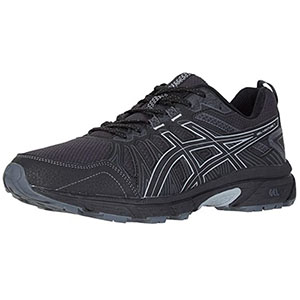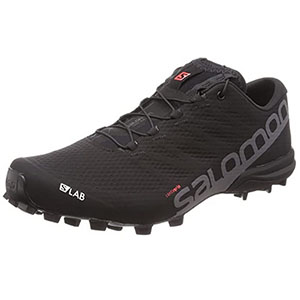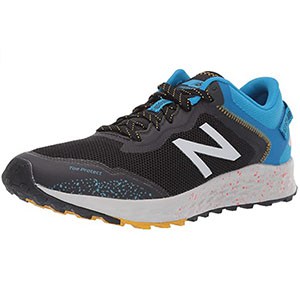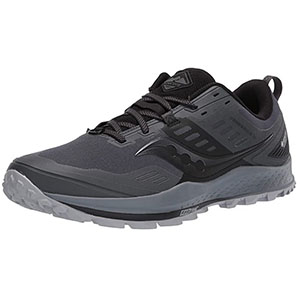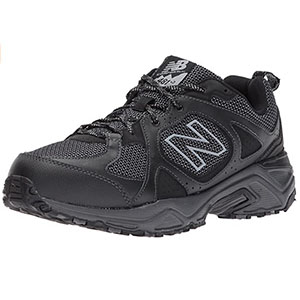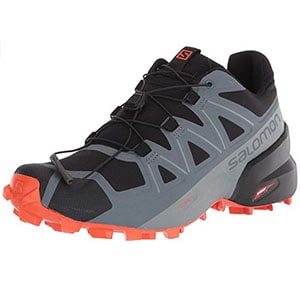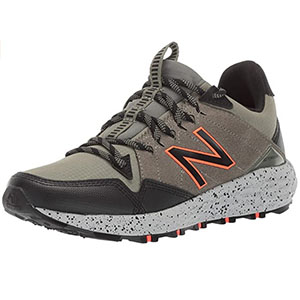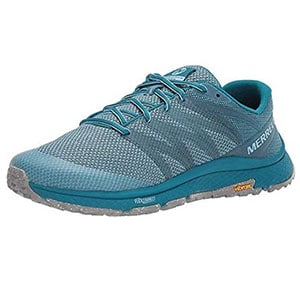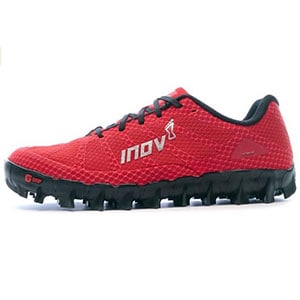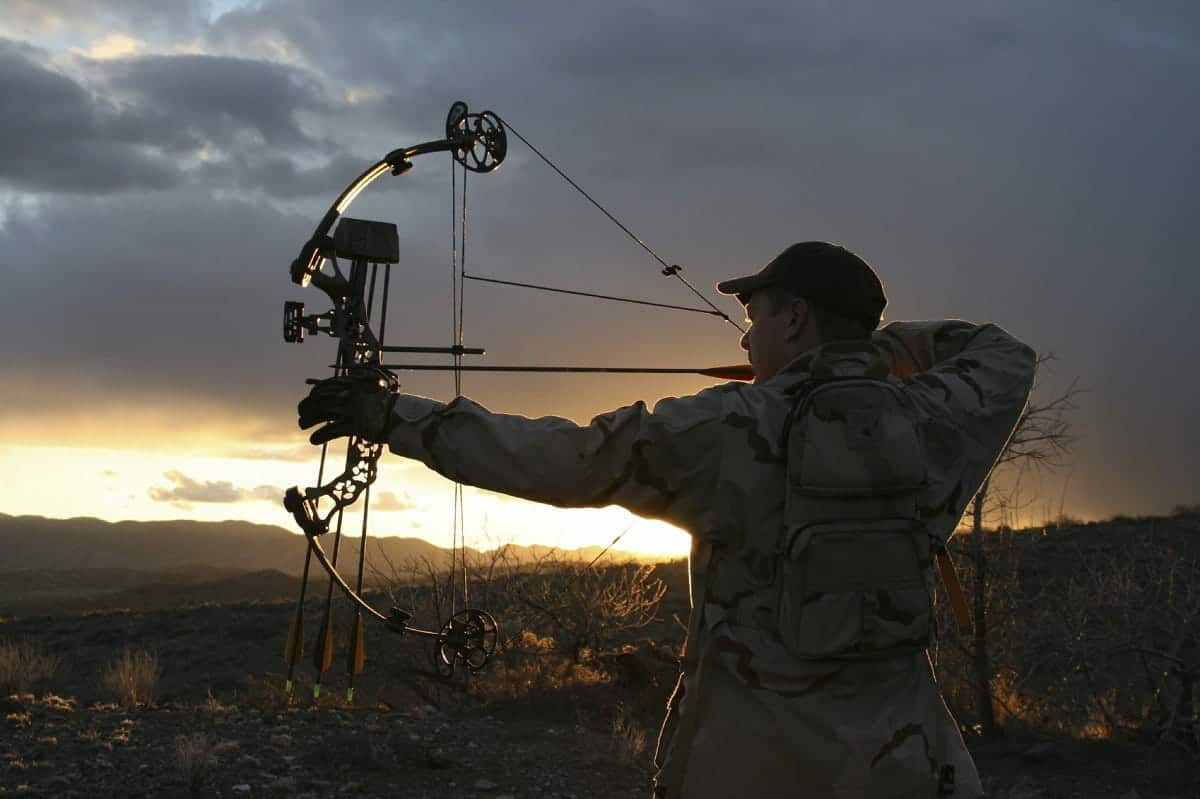Trail running shoes enable you to take your love of running off road, and to do so safely and effectively. Trail running shoes are designed and built to respond to the challenges of the trail. They provide added traction, extra stability, and have an array of subtle but important features that increase safety and performance.
Trail running shoes run the gamut from minimalist to ultra-padded, so there is bound to be one that dovetails with your running style and the trails you want to navigate. Below are the 10 best trail running shoes of 2021 as determined by our experts.
1. Asics Men’s Gel-Venture 7
The Asics Men’s Gel Venture 7 has an unassuming profile that belies its appetite for the trail. The shoe is highly breathable and absorbs shocks like they’re going out of style. The Ortholite sock liner hugs your foot in a very pleasing way that makes the shoe feel like a true extension of your leg. But the shoe is more than just comfortable. It’s tough as nails with an upper fashioned from durable synthetic leather and a reinforced toebox that protects your piggies.
The inside of the shoe is designed to promote proper gait no matter the nature of the running surface. Lateral stability is much more robust than you’ll find on a standard running shoe, and the outsole is covered in modest lugs that transition smoothly from loose to hard to wet and dry surfaces. An outstanding shoe at a reasonable price.
2. Salomon S-Lab Speed 2
If the trails you have in your sights are true backcountry beauties you’re going to need a trail running shoe that grabs hold of the ground and doesn’t let go. That pretty much sums up the Salomon S-Lab Speed 2. With its reinforced toe, sleek but sturdy upper, durable, narrow laces that don’t attract roots, and deep, hungry lugs the Speed 2 never saw a forest trail it couldn’t handle.
Those narrow laces are part of a QuickLace closing system. And they fold under at the top so that they don’t cause you to trip. Inside, there’s an EVA midsole that works with the lacing system to help ensure your feet stay horizontal even when they want to turn over. Finally, the Speed 2 is lighter than most trail running shoes, which you will appreciate on long, arduous runs.
3. New Balance Men’s Fresh Foam Arishi
We love the way this New Balance Fresh Foam Arishi lets you bound along even the most uneven trail with confidence. Lateral stability is first-rate, as is shock absorption from the oversized outsole. Up front there’s a reinforced toe box that protects you if you accidently stub your toe on a rock or tree root.
The underside of the shoe is covered with deep, effective lugs that transition effortless between surfaces. With its EVA insert and the company’s proprietary ‘Fresh Foam’ midsole you’ll skip over difficult sections of the trail without blinking an eye. Finally, the Fresh Foam Arishi is available in a half dozen color schemes, and you won’t have to mortgage the house to get them.
4. ALTRA Men’s Lone Peak 4
The Altra Lone Peak 4 provides a relatively flat stack that mimics barefoot running, but with plenty of cushioning to absorb shocks and save your ankle and knee joints. The reinforced toe box provides extra protection against stubbing your toe. It’s also a bit more spacious than the toe box on a conventional running shoe. That prevents your toes from being jammed against the front when running down trail.
The lacing is designed to stay low and out of the way, and there are hook and loop tabs that enable you to attach gators should conditions warrant them. The cherry on this particular cake is the StoneGuard tucked into the midsole that prevents you from falling victim to sharp rocks when you drive your foot into the ground.
5. Saucony Peregrine 10 GTX
The Saucony Peregrine 10 GTX is another high-performance trail running shoe that appears to be a standard running shoe, until you take a closer look. What you’ll find upon inspection is the company’s PwrFaom midsole that soaks up shocks like a sponge, a genuine rubber outsole that is durable as the day is long, and a reinforced layer within that sole that prevents dangerous objects from penetrating to your feet.
With 4 mm lugs the Peregrine 10 will chew up granular terrain, but still keep you firmly anchored to the surface when you’re scampering across large boulders. Lateral stability is excellent and the heel cup provides a snug but comfortable hold that prevents vertical slipping. The Peregrin 10 GTX is not cheap. But if you love trail running, they’re worth the stretch.
6. New Balance Men’s 481 V3
Nobody is going to mistake your New Balance 481 V3s for standard running shoes. They’re the Humvee of trail running shoes with an oversized outsole, structural reinforcement across the length and breadth of the exterior, and outstanding protection from shocks and rocks. There’s even an extra New Balance Soft Comfort Insert you can slip inside for extra cushioning.
If you’re concerned about trail running taking a toll on your knees, you might want to consider the 481 V3. Your feet will feel safe and secure when these are fully laced up. They don’t pinch but they don’t abide any slipping or sliding inside either.
7. Salomon Speedcross 5
First off, we love the way the Speedcross 5 from Salomon looks. It has an edginess to it that is strangely satisfying and seems perfectly appropriate to something like trail running. Beyond its handsome exterior though, this is a tough, effective trail running shoe that’s built for mud, gravel, dirt, exposed granite and anything else mother nature throws at you.
The grip provided by the deep, hungry lugs is uncompromising. The quick lace system lets you suit up and go. Or stop, adjust, and be back at it in seconds. Lateral stability is top-notch. The sleek profile and discrete laces help you avoid hazards. The shoe drinks up shocks all day long. And the reinforced toe box protects you from unexpected rocks and roots. They’re not the lightest trail running shoes, but you’re not likely to ever say they let you down.
8. New Balance Fresh Foam Crag Trail V1
The New Balance Fresh Foam Crag Trail V1 is a slightly ramped up version of the company’s Fresh Foam Arishi that we looked at earlier. The Crag Trail has a bit more cushioning in the sole, a more robust upper that provides rock-solid lateral stability, and a higher cuff that provides more protection from twisted ankles.
The lacing system on the Crag Trail is a little more involved than that on the Arishi. But New Balance has thrown in a nylon suppressor strap that runs up the outside of the tongue and holds the laces down to prevent them catching on roots, branches and other hazards. The shoe is designed to slip on like a bootie, while the mixture and distribution of lugs has you covered no matter what type of surface you encounter.
9. Merrell Men’s Bare Access XTR Sweeper
Some people love pushing the experiential envelope. Others just want to get some fresh air and exercise. If you are one of the latter you might want to consider the Merrell Bare Access XTR Sweeper. This is a less extreme trail running shoe than, say, the Salomon Speedcross 5 or the New Balance Crag Trail. But it still has plenty to offer those bored with the usual run around the neighborhood.
Because there is not as much structural reinforcement or cushioning in the Bare Access XTR, it’s one of the lightest trail running shoes on our list. Yet it’s still a step up from a standard running shoe when it comes to support, shock absorption and durability. The shoe is very breathable, holds your foot firmly in place through sudden changes of direction, and has a reinforced toe box to protect from rocks and roots intruding on your run.
10. Inov-8 Men’s Mudclaw 275
Last, but certainly not least, is the Inov-8 Mudclaw 275. When they say ‘claw’ they’re not kidding. These shoes were designed to grab hold of loose or sloppy surfaces and drive you forward like you’re running on asphalt. Overall stability is excellent, the 8 mm cleats are some of the most aggressive you’ll find, and the shoe’s sleek profile helps you avoid hazards.
Those deep, aggressive lugs are fashioned from graphene rubber that’s outrageously sticky. Why is that important if you’re plowing through mud? It isn’t. It’s important for when you emerge from the mud onto a hard, wet granite surface. The upper of the Mudclaw features one-piece construction that promotes structural integrity while reducing weight. And the 6 mm drop pushes you onward and upward to new personal bests.
FAQs
What Is a Trail Running Shoe?
A trail running shoe is a shoe designed specifically to handle the unique challenges of the trail. Everyone knows running is good for your health (1). But running on the same old sidewalk over and over can get monotonous. Trail running is a way to infuse new life into your running routine. But you’ll need the right footwear, or else you’ll be leaving yourself open to all manner of injury. Trail running shoes can help ensure your jog through the hills is pleasant, safe and productive.
Can’t I Just Use Road Running Shoes on the Trail?
You can. But by doing so you are increasing the probability that you will twist or even break an ankle. You also increase the risk of tripping on a trail hazard and landing hard, perhaps incurring some other kind of injury in the process. In addition, trail surfaces are often loose or muddy. Have you ever tried running through a lengthy area of mud wearing sleek, porous road shoes? It is not fun, we can tell you that. Trail running shoes are designed to respond to the unique environment of the trail. Wearing them is just common sense.
What are the Benefits of Trail Running Shoes?
Trail running shoes provide stability – Running on trails is no walk in the park. There are myriad hazards including roots, rocks, loose surfaces, fallen branches and more. Running on asphalt or concrete doesn’t demand as much of your shoes as trail running. Trail running shoes need to be firmer, i.e. more stable through the midsole. Minimalist trail running shoes sit lower to the ground and reduce the chances of turning an ankle. Some other trail running shoes have soles that flare out at the back and side to further reduce the odds of spraining an ankle (2), or worse.
Trail running shoes protect your feet – The primary reason to get good trail running shoes is to protect your feet from the many unique hazards of the trail. Most provide protection against sharp objects penetrating the sole. Most also offer some type of reinforcement in the toe to protect against breaking your toes against rocks or tree roots. In some cases, the tongue of the trail running shoe is gusseted to prevent small objects from working their way in.
Trail running shoes provide outstanding traction – The demands of the trail are different than the demands of the road or track. So the soles of a trail running shoe need to account for this. Most have tough, durable rubber soles with various sized ‘lugs’ that provide traction in dirt or mud by digging into the surface. What size lugs you need on your shoes will be determined by the type of trails you plan to run on.
Trail running shoes don’t need to be broken in – Hiking shoes are necessary if you plan on trekking long distances carrying a heavy backpack. But their innate stiffness means you need to take some time and break them in before you hit the trail (3) or your first trek will be a blister-laden pain-fest. Unlike hiking shoes, trail running shoes are good to go right out of the box.
Trail running shoes are made to get dirty – Your snow white running shoes aren’t designed for trail running. After an hour or so off road they’re likely to be soiled beyond recognition. Trail running shoes, on the other hand, take into account that you’re going to get them dirty. That means the color scheme is typically muted so that the dirt is less visible. Some even have ‘splash’ patterns integrated into the upper so it’s hard to tell what is dirt and what is design.
Trail running shoes can be used for hiking – Because they’re built for trails many people use their trail running shoes for day hikes as well. And why not? They have the grip you need, they’re light, and they’re tougher than standard running shoes. Keep in mind, however, that if you’re going on a multi-day trek with a heavy backpack you’ll need something more supportive.
Trail running shoes usually have stronger laces – Laces are not typically a problem on running shoes, until you venture onto the trail. Then there are all types of hazards that can catch on the laces and undo them. Or worse yet, cause you to trip and fall. Most trail running shoes account for this in some way. Some provide small pockets where you can tuck the ends of the laces away. While a shoe like the New Balance Foam Crag provides a lace suppressor that holds the lace down against the tongue so that they aren’t snagged by roots or branches.
Trail running shoes can be used on the road – Trail running shoes are incredibly versatile. Much more so than standard running shoes that don’t do such a great job off-road. Trail running shoes can be used on hardscrabble trails, dirt roads, concrete, blacktop, you name it. So don’t be afraid to mix things up on your next run.
Do trail running shoes have different levels of cushioning?
There are four basic levels of cushioning in trail running shoes. People in the shoe business refer to this as the ‘stack’ of the shoe. For a long time the stack of athletic shoes remained pretty much the same from shoe to shoe and manufacturer to manufacturer. That changed shortly after the turn of the century. The four generally recognized levels of cushioning today are:
Barefoot – As the name implies these are shoes that provide no discernable cushioning. They’re a lot like running barefoot, which is, after all, the way nature intended us to run. All these shoes do is protect your feet from getting cut up by debris on the trail.
Minimalist – If you like the idea of running (almost) barefoot, but have fallen arches (4) or just want a bit of arch support, a trail running shoe with minimalist cushioning may be just what the doctor ordered.
Standard – This is the level of cushioning most of us grew up with and is still the level of cushioning you get in the vast majority of athletic shoes. Not too thick, not too thin, with decent arch support. Some manufacturers have rebranded this as ‘moderate’ cushioning.
Max – The poster child of the max cushioning movement is the Hoka shoe (5). They hit the market about a decade ago and have found a lot of followers in those whose ankles are prone to rolling or who suffer from runner’s knee (6). The downside of running on marshmallows is that they’re heavier and require you to work harder to produce the same amount of forward motion.
Are all trail running shoes waterproof?
No. And the fact that they’re not is the subject of frequent and sometimes heated debate. So why aren’t all trail running shoes waterproof? After all, if they’re built for mud they should be built for water. Right? Well, yes and no. Nobody wants to be running with wet feet. But waterproof shoes are not necessarily as wonderful as they sound.
First of all, waterproofing tends to stifle breathability. So your feet are going to get incredibly hot. Second, waterproofing does a good job preventing water from soaking through the shoe’s upper. It does not do such a good job preventing water from entering around the ankle. And once that water gets in, the waterproofing will make sure it stays in.
Should trail running shoes fit a certain way?
As a general rule, you want your trail running shoes to be snug toward the heel. If your heel is lifting every time you take a step you’ll be dealing with some pretty painful blisters. Other than that, you want good arch support because trail running can be particularly hard on the arches. And you may want a bit more room at the front of the shoe than you’re used to. Simply because your feet will likely be jammed forward a lot on the irregular surface of the trail.
Is the drop important on a trail running shoe?
‘Drop’ is often a misunderstood term. It refers to how much higher the heel is off the ground when you are standing still than the toe. As such, shoes with extremely thick soles can have the same amount of drop as shoes with thin soles. As long as the difference in height between the heel and toe is the same.
Trail running itself does not call for any particular amount of heel drop. It’s mostly a matter of personal preference. Running is a more complex endeavor than most people think (7). And not everyone has the same motion when they run. Some people tend to spring along on their toes. Others tend to drive their heels into the ground. If your running style is more the latter than the former, you may want some extra cushion in the heel. This will create more of a drop toward the toe.
The Bottom Line
Trail running shoes allow you to expand your horizons by combining your love of the great outdoors with your love of running. They provide a firm, resilient platform to push off from, protect you from rolling your ankles, and keep you upright when the surface gets gnarly.
Trail running with standard running shoes may seem tempting, but sooner or later (probably sooner), the shortcomings of the standard shoe are going to come back to haunt you. And a dislocated or broken ankle can have negative effect on your overall heath for years to come. Don’t risk it. Pick up a good pair of trail running shoes and hit the high country with confidence.
